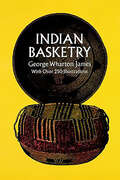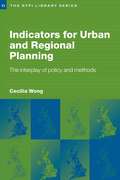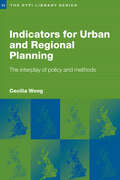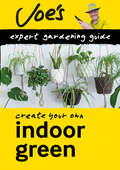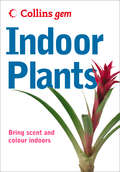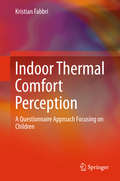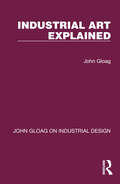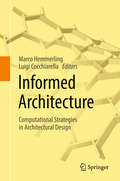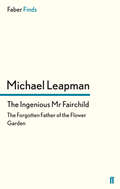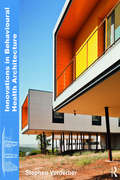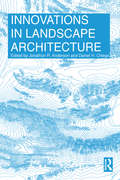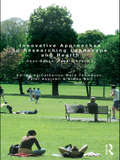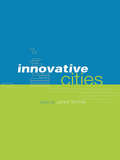- Table View
- List View
Indian Basketry
by George W. JamesSince it first publication in 1901, this pioneering study by George Wharton James, once a leading collector and authority, has become a valuable source book for American Indian basketry. From Poma mush baskets to Paiute dicing trays, Indian Basketry traces the origin, development, and fundamental principles of Indian basket designs for the major tribal units in Southwestern United States and Pacific Coast, with occasional comments on the basket weaving of a number of other North American tribes.Author of several books on the Southwest, George James has used his extensive experience in the field to compile indispensable information (much gathered directly through interviews with Indian basketmakers) covering nearly every aspect of Indian basketry: esthetics, designs, dyes, and coloration, weaving and stitching techniques (including the bamtush and dah-lah methods), basket types, tribal variation, and functional considerations, offering clear instructions for those who may be interested in reproducing these ancient American crafts. James also includes a description of various native weaving materials such as pine root, bark, sumac, willow, twigs, fern stalks, grass and palm fronds, with suggestions regarding the ways in which the Indians wove shells, feathers, beads, leather, and pine needles into their basket designs.The book is a valuable aid for the artist, designer, and craftsman, or even for the beginner, who may wish to re-create authentic and often extinct basket forms and decorative motifs. It is also most useful to the collector, cultural historians, ethnologist, scholar, or buff, who desires to know more about specific aspects of Indian basketry, or about Indian arts in general. As an important contribution to the historiography of American Indian culture, this may be one of the most practical Indian basketry books that you could own.
Indicators for Urban and Regional Planning: The Interplay of Policy and Methods (RTPI Library Series)
by Cecilia WongThis book focuses on the measurement and utilisation of quantitative indicators in the urban and regional planning fields. There has been a resurgence of academic and policy interest in using indicators to inform planning, partly in response to the current government's information intensive approach to decision-making. The content of the book falls into three broad sections: indicators usage and policy-making; methodological and conception issues; and case studies of policy indicators.
Indicators for Urban and Regional Planning: The Interplay of Policy and Methods (RTPI Library Series)
by Cecilia WongThis book focuses on the measurement and utilisation of quantitative indicators in the urban and regional planning fields. There has been a resurgence of academic and policy interest in using indicators to inform planning, partly in response to the current government's information intensive approach to decision-making. The content of the book falls into three broad sections: indicators usage and policy-making; methodological and conception issues; and case studies of policy indicators.
Indoor Green: Create Your Own Green Space With This Expert Gardening Guide (Collins Gardening)
by Joe Swift Collins BooksTransform your home with tips from expert gardener Joe Swift. Indoor plants brighten our homes, connect us with the natural world and improve our physical and mental health. If you want to turn your living space into an Indoor Green haven, expert gardener Joe Swift shows you how with practical, easy-to-follow advice.
Indoor Plants (Collins Gem)
by CollinsA practical, easy-to-use, pocketable guide covering all the basics of choosing and caring for plants in your home.
Indoor Thermal Comfort Perception: A Questionnaire Approach Focusing on Children (SpringerBriefs in Applied Sciences and Technology)
by Kristian FabbriProviding a methodology for evaluating indoor thermal comfort with a focus on children, this book presents an in-depth examination of children’s perceptions of comfort. Divided into two sections, it first presents a history of thermal comfort, the human body and environmental parameters, common thermal comfort indexes, and guidelines for creating questionnaires to assess children’s perceptions of indoor thermal comfort. It then describes their understanding of the concepts of comfort and energy, and the factors that influence that perception. In this context, it takes into account the psychological and pedagogical aspects of thermal comfort judgment, as well as architectural and environmental characteristics and equips readers with the knowledge needed to effectively investigate children’s perspectives on environmental ergonomics.The research field of indoor thermal comfort adopts, on the one hand, physical parameter measurements and comfort indexes (e.g. Predicted Mean Vote (PMV) or adaptive comfort), and on the other, an ergonomic assessment in the form of questionnaires. However the latter can offer only limited insights into the issue of comfort, as children often use different terms than adults to convey their experience of thermal comfort. The books aims to address this lack of understanding with regard to children’s perceptions of indoor thermal comfort.The book is intended for HVAC engineers and researchers, architects and researchers interested in thermal comfort and the built environment. It also provides a useful resource for environmental psychologists, medical and cognitive researchers.
Industrial Art Explained (John Gloag On Industrial Design Ser.)
by John GloagOriginally published in 1934 this book became recognised as one of the principal standard works on industrial design and industrial architecture. The chapters explain the complete operation, character and background history of industrial art, its relation to architecture, materials, industrial production and retail distribution. It is fully illustrated with line drawings and photographs.
Industrial Art Explained (John Gloag On Industrial Design Ser.)
by John GloagOriginally published in 1934 this book became recognised as one of the principal standard works on industrial design and industrial architecture. The chapters explain the complete operation, character and background history of industrial art, its relation to architecture, materials, industrial production and retail distribution. It is fully illustrated with line drawings and photographs.
Informed Architecture: Computational Strategies in Architectural Design
by Marco Hemmerling Luigi CocchiarellaThis book connects the different topics and professions involved in information technology approaches to architectural design, ranging from computer-aided design, building information modeling and programming to simulation, digital representation, augmented and virtual reality, digital fabrication and physical computation. The contributions include experts’ academic and practical experiences and findings in research and advanced applications, covering the fields of architecture, engineering, design and mathematics. What are the conditions, constraints and opportunities of this digital revolution for architecture? How do processes change and influence the result? What does it mean for the collaboration and roles of the partners involved. And last but not least: how does academia reflect and shape this development and what does the future hold? Following the sequence of architectural production - from design to fabrication and construction up to the operation of buildings - the book discusses the impact of computational methods and technologies and its consequences for the education of future architects and designers. It offers detailed insights into the processes involved and considers them in the context of our technical, historical, social and cultural environment. Intended mainly for academic researchers, the book is also of interest to master’s level students.
Infrastructural Optimism
by Linda C. SamuelsInfrastructural Optimism investigates a new kind of twenty-first-century infrastructure, one that encourages a broader understanding of the interdependence of resources and agencies, recognizes a rightfully accelerated need for equitable access and distribution, and prioritizes rising environmental diligence across the design disciplines. Bringing together urban history, case studies, and speculative design propositions, the book explores and defines infrastructure as the basis for a new form of urbanism, emerging from the intersection of architecture, landscape architecture, and urban design. In defining this new infrastructure, the book introduces new dynamic and holistic performance metrics focused on "measuring what matters" over growth for the sake of growth and twelve criteria that define next generation infrastructure. By shifting the focus of infrastructure – our largest public realm – to environmental symbiosis and quality of life for all, design becomes a catalytic component in creating a more beautiful, productive, and optimistic future with Infrastructural Urbanism as its driver. Infrastructural Optimism will be invaluable to design, non-profit and agency professionals, and faculty and students in the fields of architecture, landscape architecture, and urban design, working in partnership with engineers, hydrologists, ecologists, urban planners, community members, and others who shape the built environment through the expanded field of infrastructure.
Infrastructural Optimism
by Linda C. SamuelsInfrastructural Optimism investigates a new kind of twenty-first-century infrastructure, one that encourages a broader understanding of the interdependence of resources and agencies, recognizes a rightfully accelerated need for equitable access and distribution, and prioritizes rising environmental diligence across the design disciplines. Bringing together urban history, case studies, and speculative design propositions, the book explores and defines infrastructure as the basis for a new form of urbanism, emerging from the intersection of architecture, landscape architecture, and urban design. In defining this new infrastructure, the book introduces new dynamic and holistic performance metrics focused on "measuring what matters" over growth for the sake of growth and twelve criteria that define next generation infrastructure. By shifting the focus of infrastructure – our largest public realm – to environmental symbiosis and quality of life for all, design becomes a catalytic component in creating a more beautiful, productive, and optimistic future with Infrastructural Urbanism as its driver. Infrastructural Optimism will be invaluable to design, non-profit and agency professionals, and faculty and students in the fields of architecture, landscape architecture, and urban design, working in partnership with engineers, hydrologists, ecologists, urban planners, community members, and others who shape the built environment through the expanded field of infrastructure.
Infrastructure Planning and Finance: A Smart and Sustainable Guide
by Vicki Elmer Adam LeiglandInfrastructure Planning and Finance is a non-technical guide to the engineering, planning, and financing of major infrastucture projects in the United States, providing both step-by-step guidance, and a broad overview of the technical, political, and economic challenges of creating lasting infrastructure in the 21st Century. Infrastructure Planning and Finance is designed for the local practitioner or student who wants to learn the basics of how to develop an infrastructure plan, a program, or an individual infrastructure project. A team of authors with experience in public works, planning, and city government explain the history and economic environment of infrastructure and capital planning, addressing common tools like the comprehensive plan, sustainability plans, and local regulations. The book guides readers through the preparation and development of comprehensive plans and infrastructure projects, and through major funding mechanisms, from bonds, user fees, and impact fees to privatization and competition. The rest of the book describes the individual infrastructure systems: their elements, current issues and a 'how-to-do-it' section that covers the system and the comprehensive plan, development regulations and how it can be financed. Innovations such as decentralization, green and blue-green technologies are described as well as local policy actions to achieve a more sustainable city are also addressed. Chapters include water, wastewater, solid waste, streets, transportation, airports, ports, community facilities, parks, schools, energy and telecommunications. Attention is given to how local policies can ensure a sustainable and climate friendly infrastructure system, and how planning for them can be integrated across disciplines.
Infrastructure Planning and Finance: A Smart and Sustainable Guide
by Vicki Elmer Adam LeiglandInfrastructure Planning and Finance is a non-technical guide to the engineering, planning, and financing of major infrastucture projects in the United States, providing both step-by-step guidance, and a broad overview of the technical, political, and economic challenges of creating lasting infrastructure in the 21st Century. Infrastructure Planning and Finance is designed for the local practitioner or student who wants to learn the basics of how to develop an infrastructure plan, a program, or an individual infrastructure project. A team of authors with experience in public works, planning, and city government explain the history and economic environment of infrastructure and capital planning, addressing common tools like the comprehensive plan, sustainability plans, and local regulations. The book guides readers through the preparation and development of comprehensive plans and infrastructure projects, and through major funding mechanisms, from bonds, user fees, and impact fees to privatization and competition. The rest of the book describes the individual infrastructure systems: their elements, current issues and a 'how-to-do-it' section that covers the system and the comprehensive plan, development regulations and how it can be financed. Innovations such as decentralization, green and blue-green technologies are described as well as local policy actions to achieve a more sustainable city are also addressed. Chapters include water, wastewater, solid waste, streets, transportation, airports, ports, community facilities, parks, schools, energy and telecommunications. Attention is given to how local policies can ensure a sustainable and climate friendly infrastructure system, and how planning for them can be integrated across disciplines.
Infrastructure, Wellbeing and the Measurement of Happiness
by Roe Jenny Seaman Kate Mahmoudi HodaThis book takes an interdisciplinary approach to our understanding of infrastructure, and it’s influence on happiness and wellbeing, by examining the concept from economic, human development, architectural, urban planning, psychological, and ethical points of view. Providing insights from both research and practice the volume discusses how to develop happier cities and improve urban infrastructure for the wellbeing of the whole population. The book puts forth the argument that it is only in understanding the true nature of infrastructure’s reach – how it connects, supports, and enlivens human beings – that we can truly begin to understand infrastructure’s possibilities. It connects infrastructure to that most elusive of human qualities – happiness – examining the way infrastructure is fundamentally tied to human values and human well-being. The book seeks to suggest novel approaches, identify outmoded undertakings, and define new possibilities in order to maximize infrastructure’s impact for all people – with a focus on diversity, inclusion and equity. In seeking to define infrastructure broadly and examine its possibilities systematically this book brings together theory and evidence from multiple disciplinary perspectives including, sociology, urban studies, architecture, economics, and public health in order to advance a startling claim – that our lives, and the lives of others, can be substantively improved by greater adhesion to the principles and practices of infrastructure design for happiness and wellbeing.
Infrastructure, Wellbeing and the Measurement of Happiness
by Hoda Mahmoudi Jenny Roe Kate SeamanThis book takes an interdisciplinary approach to our understanding of infrastructure, and it’s influence on happiness and wellbeing, by examining the concept from economic, human development, architectural, urban planning, psychological, and ethical points of view. Providing insights from both research and practice the volume discusses how to develop happier cities and improve urban infrastructure for the wellbeing of the whole population. The book puts forth the argument that it is only in understanding the true nature of infrastructure’s reach – how it connects, supports, and enlivens human beings – that we can truly begin to understand infrastructure’s possibilities. It connects infrastructure to that most elusive of human qualities – happiness – examining the way infrastructure is fundamentally tied to human values and human well-being. The book seeks to suggest novel approaches, identify outmoded undertakings, and define new possibilities in order to maximize infrastructure’s impact for all people – with a focus on diversity, inclusion and equity. In seeking to define infrastructure broadly and examine its possibilities systematically this book brings together theory and evidence from multiple disciplinary perspectives including, sociology, urban studies, architecture, economics, and public health in order to advance a startling claim – that our lives, and the lives of others, can be substantively improved by greater adhesion to the principles and practices of infrastructure design for happiness and wellbeing.
The Ingenious Mr Fairchild: The Forgotten Father of the Flower Garden
by Michael LeapmanBy the early eighteenth century botanists were inching towards the shocking truth that plants had male and female organs and reproduced sexually. The first person to realize the practical implications of this was London nurseryman and author Thomas Fairchild. By transferring the pollen of a sweet William into the pistil of a carnation, he created a new plant that became known as 'Fairchild's Mule': the first man-made hybrid in Europe. But this primitive form of genetic engineering aroused a scientific and religious furore.Michael Leapman offers fascinating and colourful detail about the life and times of Fairchild, a troubled, gentle soul whose pioneering work changed the course of horticulture and paved the way for the growth of gardening as a cultural obsession.'A beguiling perambulation around the Georgian nursery trade.' Sir Roy Strong, Daily Mail
Ingrained: An uplifting and passionate memoir about woodworking and craftsmanship
by Callum Robinson‘A debut that’s both a paean to the art of woodworking and a memoir about creative endeavours’ – OBSERVER'Mesmeric' SPECTATOR'Robinson’s prose is humorous and macho, taking its lead from the gruff, sensual delivery of food writer Anthony Bourdain… But wood, in all its facets, remains at the heart of his writing.' FINANCIAL TIMES'A beautifully cut and crafted masterpiece inlaid with insight and polished with the pure joy of nature.’CHRIS PACKHAM, author of Fingers in the Sparkle Jar: A Memoir'Original. Rare. As beautiful as trees... A masterpiece.'JOHN LEWIS-STEMPEL, author of Meadowland, The Running Hare and The Wood'A book that is covertly a love poem disguised as a father-and-son story, an apprentice’s learning of an exotic craft, a hymn to the eternal mystery of trees, and a tribute to the flat-out joy of gifting. Enchanting.'BILL BUFORD, author of Heat and Dirt'A delightful book about the art of craft; a hard-carved woodworking romance written with tenderness and an almost sensual attention to detail. I can smell the resin and the soft, fresh sawdust. I can feel the bite of dense grain beneath the blade. Quite magical.'CAL FLYN, author of Islands of Abandonment.........................................................................................................Ingrained is a love letter to trees, timber and craftsmanship – and to finding your own voice. The eldest son of a Master Woodworker, Callum Robinson spent his childhood surrounded by wood and trees, absorbing craft lessons in his father’s workshop, playing amongst the sycamore, oak and Scots pine that bordered his home. In time he became his father’s apprentice, helping to create exquisite bespoke objects. But eventually the need to find his own path led him to establish his own workshop; to chase ever bigger and more commercial projects, to business meetings, bright lights and bureaucracy, to lose touch with his roots. Until the devastating loss of one major job threatened to bring it all crashing down. Faced with the end of his business, his team and everything he had worked so hard to build, he was forced to question what mattered most.In beautifully wrought prose, Callum tells the story of returning to the workshop, and to the wood; to handcrafting furniture for people who will love it, and then pass it on to the next generation – antidotes to a culture where everything seems so easily disposable. As he does so, he brings us closer to nature, and to the physical act of creation. Close enough to smell the sawdust, to see the wood’s grain and character and to feel the magic of furniture coming to life. At the same time, we begin to understand how he has been shaped, as both a craftsman and a son.Blending memoir and nature writing at its finest, Ingrained is an uplifting meditation on the challenges of working with your hands in our modern age, on community, consumerism, and the beauty of the natural world – one that asks us to see our local trees, and our own wooden objects, in a new and revelatory light.
Innovating Strategies and Solutions for Urban Performance and Regeneration (Advances in Science, Technology & Innovation)
by Cristina Piselli Haşim Altan Osman Balaban Peleg KremerThis book focuses on enhancing urban regeneration performance and strategies that pave the way toward sustainable urban development models and solutions. The book at hand thoroughly examines the latest studies on the regeneration of urban areas and attempts at alleviating the negative impacts associated with high population density and urban heat effects. It gathers contributions that combine theoretical reflections and international case studies on urban regeneration and transformation with the single goal of tackling existing social and economic imbalances and developing new solutions. The primary audience of this book will be from the field of architecture and urban planning, offering new insights on how to address the myriad of problems that our cities are facing.
Innovations in Behavioural Health Architecture
by Stephen Verderber***WINNER OF A NAUTILUS 2018 SILVER MEDAL BOOK AWARD*** Innovations in Behavioural Health Architecture is the most comprehensive book written on this topic in more than 40 years. It examines the ways in which healthcare architecture can contribute, as a highly valued informational and reference source, to the provision of psychiatric and addictive disorder treatment in communities around the world. It provides an overview of the need for a new generation of progressively planned and designed treatment centres – both inpatient and outpatient care environments – and the advantages, challenges, and opportunities associated with meeting the burgeoning need for treatment settings of this type. Additional chapters address the specifics of geriatric psychiatry and its architectural ramifications in light of the rapid aging of societies globally and provide a comprehensive compendium of planning and design considerations for these places in both inpatient and outpatient care contexts. Finally, the book presents an expansive and fully illustrated set of international case studies that express state-of-the-art advancements in architecture for behavioural healthcare.
Innovations in Behavioural Health Architecture
by Stephen Verderber***WINNER OF A NAUTILUS 2018 SILVER MEDAL BOOK AWARD*** Innovations in Behavioural Health Architecture is the most comprehensive book written on this topic in more than 40 years. It examines the ways in which healthcare architecture can contribute, as a highly valued informational and reference source, to the provision of psychiatric and addictive disorder treatment in communities around the world. It provides an overview of the need for a new generation of progressively planned and designed treatment centres – both inpatient and outpatient care environments – and the advantages, challenges, and opportunities associated with meeting the burgeoning need for treatment settings of this type. Additional chapters address the specifics of geriatric psychiatry and its architectural ramifications in light of the rapid aging of societies globally and provide a comprehensive compendium of planning and design considerations for these places in both inpatient and outpatient care contexts. Finally, the book presents an expansive and fully illustrated set of international case studies that express state-of-the-art advancements in architecture for behavioural healthcare.
Innovations in Landscape Architecture
by Jonathon R. Anderson Daniel H. OrtegaThis inspiring and thought-provoking book explores how recent innovations in landscape architecture have uniquely positioned the practice to address complex issues and technologies that affect our built environment. The changing and expanding nature of "landscape" make it more important than ever for landscape architects to seek innovation as a critical component in the forward development of a contemporary profession that merges expansive ideas and applications. The editors bring together leading contributors who are experts in new and pioneering approaches and technologies within the fields of academic and professional landscape architecture. The chapters explore digital technology, design processes and theoretical queries that shape the contemporary practice of landscape architecture. Topics covered include: Digital design Fabrication and prototyping Emerging technology Visualization of data System theory Concluding the book are case studies looking at the work of two landscape firms (PEG and MYKD) and two academic departments (Illinois Institute of Technology and the Rhode Island School of Design), which together show the novel and exciting directions that landscape is already going in.
Innovations in Landscape Architecture
by Jonathon R. Anderson Daniel H. OrtegaThis inspiring and thought-provoking book explores how recent innovations in landscape architecture have uniquely positioned the practice to address complex issues and technologies that affect our built environment. The changing and expanding nature of "landscape" make it more important than ever for landscape architects to seek innovation as a critical component in the forward development of a contemporary profession that merges expansive ideas and applications. The editors bring together leading contributors who are experts in new and pioneering approaches and technologies within the fields of academic and professional landscape architecture. The chapters explore digital technology, design processes and theoretical queries that shape the contemporary practice of landscape architecture. Topics covered include: Digital design Fabrication and prototyping Emerging technology Visualization of data System theory Concluding the book are case studies looking at the work of two landscape firms (PEG and MYKD) and two academic departments (Illinois Institute of Technology and the Rhode Island School of Design), which together show the novel and exciting directions that landscape is already going in.
Innovative Approaches to Researching Landscape and Health: Open Space: People Space 2
by Catharine Ward Thompson Peter Aspinall Simon BellOur modern lifestyles often cause us to spend more time sitting behind a desk than being active outdoors. At the same time, our general health is deteriorating. The alarming rise in obesity, sedentary lifestyles and mental ill-health across the developed world has resulted in an urgent desire to understand how the environment, in particular the outdoor environment, influences health. This book addresses the growing interest in salutogenic environments - landscapes that support healthy lifestyles and promote well-being – and the need for innovative methods to research them. Drawing on multidisciplinary approaches from environmental psychology, health sciences, urban design, landscape architecture and horticulture, it questions how future research can be better targeted to inform policy and practice in health promotion. The contributing authors are international experts in researching landscape, health and the environment, drawn together by OPENspace directors who have a unique reputation in this area. This pioneering book is a valuable resource for postgraduate researchers and practitioners in both environmental and health studies.
Innovative Approaches to Researching Landscape and Health: Open Space: People Space 2
by Catharine Ward Thompson Peter Aspinall Simon BellOur modern lifestyles often cause us to spend more time sitting behind a desk than being active outdoors. At the same time, our general health is deteriorating. The alarming rise in obesity, sedentary lifestyles and mental ill-health across the developed world has resulted in an urgent desire to understand how the environment, in particular the outdoor environment, influences health. This book addresses the growing interest in salutogenic environments - landscapes that support healthy lifestyles and promote well-being – and the need for innovative methods to research them. Drawing on multidisciplinary approaches from environmental psychology, health sciences, urban design, landscape architecture and horticulture, it questions how future research can be better targeted to inform policy and practice in health promotion. The contributing authors are international experts in researching landscape, health and the environment, drawn together by OPENspace directors who have a unique reputation in this area. This pioneering book is a valuable resource for postgraduate researchers and practitioners in both environmental and health studies.
Innovative Cities
by James SimmieInnovative Cities presents a unique international comparison of innovation in Amsterdam, London, Milan, Paris and Stuttgart. Based on research funded by the ESRC program on 'Cities: Competitiveness and Cohesion', it compares and contrasts the reasons why these sites are among the top ten innovative cities in Europe. Innovation is one of the key driving forces of economic growth in modern economies.The research reported here takes a careful and directly comparable look at what characteristics and conditions in the five cities have led to the flourishing of innovation in them. Researchers with detailed local knowledge have applied the same analytical tools and survey techniques to investigating this question and the result present a unique international comparison of innovation in the five cities.
